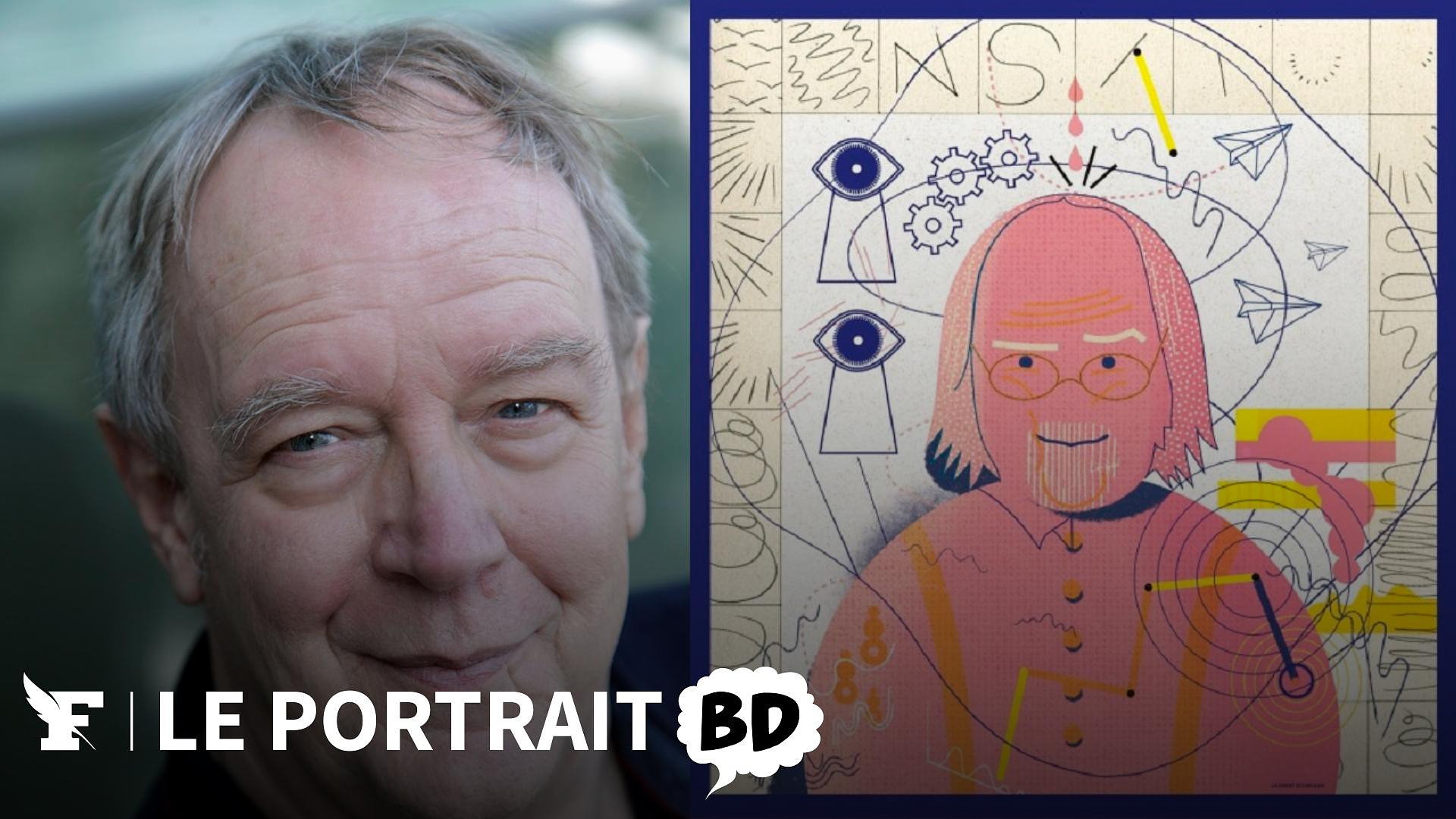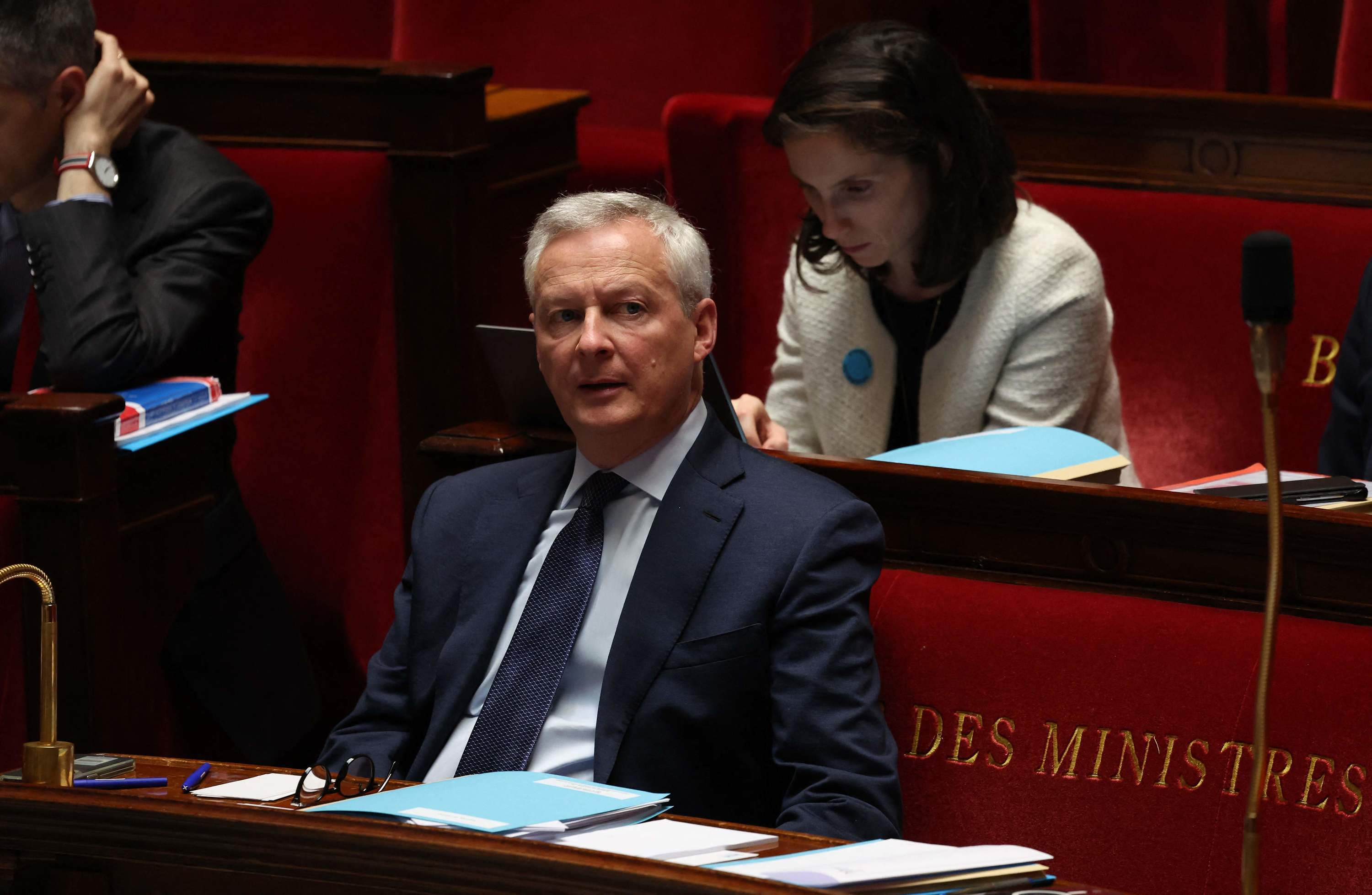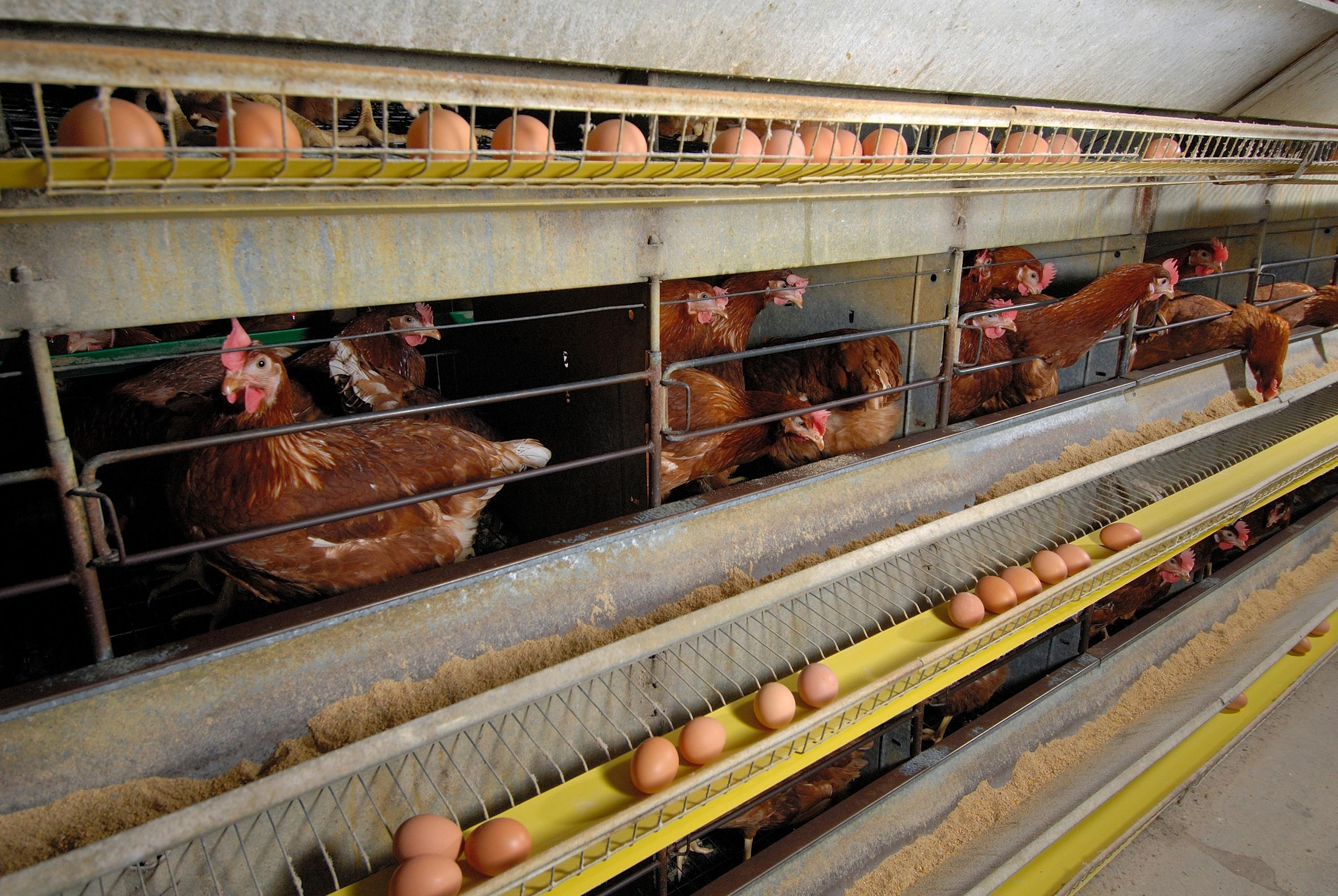Special envoy to Angoulême
When a comic book lover explores the shelves of a bookstore or library, it is probably in search of a visual favorite. A hero with charismatic features, a unique graphic style, captivating coloring... What about the screenwriters? More discreet than their illustrator colleagues, these world designers, masters in the art of storytelling – even manipulation – nevertheless play an essential role. Some designers willingly rely on their skills, sometimes giving birth to unforgettable tandems: François Schuiten and Benoît Peeters (Les Cités obscures), Grzegorz Rosiński and Jean Van Hamme (Thorgal), Albert Uderzo and René Goscinny (Asterix), etc.
The father of Little Nicolas (with Sempé) rightly gave his name to a trophy created in 1988 rewarding the best comic book scenarios. 2023 winner of this René-Goscinny prize for Cauchemars ex machina, Thierry Smolderen is benefiting from a retrospective entitled “The screenplay is a DIY”, at the Vaisseau Mœbius in Angoulême, until May 5, 2024. The Belgian screenwriter, famous for multi-award winning albums Souvenirs of the Empire of the Atome and L'Été Diabolik (with Alexandre Clérisse), agreed to tour his exhibition with us. The opportunity to discuss his numerous collaborations and his conception of the profession of screenwriter.
“I didn’t want to talk about the scenario on a technical level,” Thierry Smolderen announced from the outset. What interests me are the reasons behind the rules, and the reasons always have to do with the position of the reader, the communication relationship between him and the story. The very title of the exhibition, “The scenario is a DIY”, already announced the color... He who is at the same time author, theoretician, researcher and teacher – he participated in the creation in 2006-2007 of the master comics from the University of Poitiers – values the empirical approach and believes that “everyone must construct their practice in a somewhat self-taught way”.
Placed at the start of the route, a small room is devoted to Nightmares ex machina. This ingenious comic strip, drawn by Jorge González, features two crime writers recruited to develop a perfect crime. An elegant way of dissecting the screenwriter's work through fiction and "inviting the reader into this dizzying game of a story in the process of being constructed": the ideas that come, evolve or are discarded, the logical errors, the solutions to be found... Thierry Smolderen takes the opportunity to highlight novels dear to his eyes which “allow us to see the internal mechanism of the production of fiction”: Le Monde des Ā d’A. E van Vogt, The Island of Thirty Coffins by Maurice Leblanc and Game of Massacre by J. T. Rogers. “If I loved detective novels and science fiction so much [in my youth], it’s because I identified more with the writer than with the characters,” smiles the screenwriter.
Born in Brussels in 1954, Thierry Smolderen published his first theoretical essay on comics in 1983: Les Carnets (stolen) du Major, or the adventures of Hergé and Mœbius serialists. A work of comparison presented in the central space of the exhibition, including copies of Le Petit Vingtième, where Tintin was published, and a large fresco created by Laurent Bourlaud on Le Garage hermétique, an exercise in jubilant SF improvisation drawn by Jean Giraud's double and initially published in Métal Hurlant. The “blank page protocol”!
While so-called real comics (autobiography, reporting, popular science, etc.) are taking a growing place in the landscape of sequential art, Thierry Smolderen works only in the field of fiction and thinks that it is not necessarily necessary contrast the two approaches. According to him, “fiction is not part of the family of lies. For me, it is a simulation in the almost technical sense of the term, to produce an impression of reality. It's an experiment on the moment when reading becomes a bubble of parallel reality.
Indeed, one of the ways to create this “reality bubble” is to constantly stimulate the reader’s mind. On another fresco in the exhibition, drawn by Alexandre Clérisse and inspired by the work of Howard Gardner (Frames of Mind), Thierry Smolderen reminds us that certain everyday actions are done “on autopilot”, such as driving a car on a known route. , without real participation from the person in charge. “We shouldn’t write a story like that,” assures the screenwriter. We must constantly create dysfunctions, which forces the reader to not read automatically, and therefore with a much greater feeling of immersion” And to cite a few examples from Tintin: Haddock, Tournesol and the Dupondts bring many verbal dysfunctions, crossing the waterfall to enter the world of the Incas is a spatial malfunction, the Castafiore is a champion of musical dysfunction, etc. This theory constitutes “a practical toolbox” (and it is one of the rare “technical” parts of the exhibition!).
Continuing our wandering allows us to understand the diversity of the illustrators with whom Thierry Smolderen has collaborated throughout his career. “As a general rule, it is the drawing of a designer that arouses in me a desire for a scenario,” explains the man who likes to take a look at artists’ sketchbooks to immerse himself in their style. The style of the cartoonists I work with is an envelope in which I put myself when I write my stories.
It was in 1987 that Thierry Smolderen published his first comic book script: volume 2 of Hybrides, with Séraphine drawing. Isn’t it destabilizing to join a series that has already started? “It’s rather a good thing,” replies the screenwriter. There is a kind of obviousness of what we are supposed to do, we take on characters so we have less weight. This fruitful collaboration will continue until the fourth and final volume. “The relationship with Séraphine was really excellent. And then she gave me a great chance because that’s what got me started!”
Reissued in its entirety in January 2024, Convoi (formerly named Karen Springwell, with Philippe Gauckler on the drawing) is striking today with its pioneering scenario based on a hyperimmersive virtual world, a concrete materialization of the idea of a “reality bubble”. “In 1990, there was no internet yet, virtual reality only appeared in cutting-edge scientific journals, massively multiplayer games did not exist either,” recalls Thierry Smolderen, at the time a fan of arcade games such as Tron and Asteroid. “Philippe Gauckler's sister, Geneviève, a very renowned graphic designer, made us a small logo for each of the interfaces”, in the style of the television channel MTV, which arrived in France in 1988.
Illustrated by the Italian Enrico Marini, Gipsy (1993-2002) recounts the adventures of a trucker plunged into a new ice age: “A tribute to picaresque comics, in the old style, with almost caricatured exaggerations... We had a lot of fun writing that,” recalls Thierry Smolderen. Indeed, the frenzied road action sequences on display make you want... Another science fiction series, the techno-thriller Ghost Money (2009-2016), anticipated the rise of cryptocurrencies. Thierry Smolderen is full of praise for the “frantic realism” of the designer Dominique Bertail, his friend for three decades, who today devotes himself to the historical comic strip Madeleine, Résistance. “If we had the energy and availability, we would do 25 projects together!”
In terms of inspiring people, Thierry Smolderen cites the Grand Prix of the 2024 Angoulême Festival: “The influence of people like Posy Simmonds was strong for me in the transition between a classic adventure comic and a comic that closer to the graphic novel, playing on style and varying degrees of writing. It freed me a lot!” Staying in the field of innovations, a section of wall evokes the great adventure Coconino World from 1999, a comics webzine (now closed) which allowed young authors to express themselves, notably Lisa Mandel.
Let's finish this non-exhaustive tour of collaborations with Jean-Philippe Bramanti, "a wonderful but very secretive designer, very artistic, who has little to do with commerce." He and Thierry Smolderen have designed a fictional biography of Windsor McKay nourished by “transdimensional brawls in New York in the 1910s”. A film adaptation almost saw the light of day: “An option was taken twice by Jude Law, who had discovered this book in a bookstore, who had really liked it and thought there was a way to make it a movie. Covid arrived and the project fell through… for the moment.”
Little Nemo's father is also found in the subtitle of the essay Births of Comics, from William Hogarth to Winsor McCay, published in 2009 and nominated for the prestigious Eisner Awards. Who is this William Hogarth? An 18th century English satirical painter! Thierry Smolderen therefore traces the origins of comics long before Rodolphe Töpffer...
The Belgian screenwriter is currently interested in “19th century reporting plates in major current affairs newspapers such as The Graphic and The Illustrated London News. It’s interesting because it’s a sector that hasn’t been studied at all by comic strip historians!” Four pages are shown at the end of the exhibition but the screenwriter has 300. “This is one of the things that also inspires me a lot: to delve into the past to show that there are other ways of bringing the text and image..."
Exhibition “The scenario is a DIY”, at the Vaisseau Mœbius, 121 rue de Bordeaux, in Angoulême, until May 5, 2024.

 What is chloropicrin, the chemical agent that Washington accuses Moscow of using in Ukraine?
What is chloropicrin, the chemical agent that Washington accuses Moscow of using in Ukraine? Poland, big winner of European enlargement
Poland, big winner of European enlargement In Israel, step-by-step negotiations for a ceasefire in the Gaza Strip
In Israel, step-by-step negotiations for a ceasefire in the Gaza Strip BBVA ADRs fall almost 2% on Wall Street
BBVA ADRs fall almost 2% on Wall Street Sánchez cancels his agenda and considers resigning: "I need to stop and reflect"
Sánchez cancels his agenda and considers resigning: "I need to stop and reflect" The Federal Committee of the PSOE interrupts the event to take to the streets with the militants
The Federal Committee of the PSOE interrupts the event to take to the streets with the militants Repsol: "We want to lead generative AI to guarantee its benefits and avoid risks"
Repsol: "We want to lead generative AI to guarantee its benefits and avoid risks" Osteoarthritis: an innovation to improve its management
Osteoarthritis: an innovation to improve its management The yen jumps 3% then falls again, amid speculation of Japanese intervention
The yen jumps 3% then falls again, amid speculation of Japanese intervention A very busy Friday on the roads of Île-de-France before the Ascension Bridge
A very busy Friday on the roads of Île-de-France before the Ascension Bridge Fraud: the government is preparing new measures for the fall
Fraud: the government is preparing new measures for the fall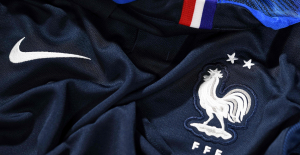 Nike breaks the bank to keep the Blues jersey
Nike breaks the bank to keep the Blues jersey Madonna ends her world tour with a giant - and free - concert in Copacabana
Madonna ends her world tour with a giant - and free - concert in Copacabana Harry Potter: Daniel Radcliffe “really saddened” by his final breakup with J.K. Rowling
Harry Potter: Daniel Radcliffe “really saddened” by his final breakup with J.K. Rowling Leviathan, New York Trilogy... Five books by Paul Auster that you must have read
Leviathan, New York Trilogy... Five books by Paul Auster that you must have read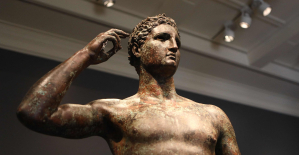 Italy wins a decisive round against an American museum for the restitution of an ancient bronze
Italy wins a decisive round against an American museum for the restitution of an ancient bronze Omoda 7, another Chinese car that could be manufactured in Spain
Omoda 7, another Chinese car that could be manufactured in Spain BYD chooses CA Auto Bank as financial partner in Spain
BYD chooses CA Auto Bank as financial partner in Spain Tesla and Baidu sign key agreement to boost development of autonomous driving
Tesla and Baidu sign key agreement to boost development of autonomous driving Skoda Kodiaq 2024: a 'beast' plug-in hybrid SUV
Skoda Kodiaq 2024: a 'beast' plug-in hybrid SUV The home mortgage firm rises 3.8% in February and the average interest moderates to 3.33%
The home mortgage firm rises 3.8% in February and the average interest moderates to 3.33% This is how housing prices have changed in Spain in the last decade
This is how housing prices have changed in Spain in the last decade The home mortgage firm drops 10% in January and interest soars to 3.46%
The home mortgage firm drops 10% in January and interest soars to 3.46% The jewel of the Rocío de Nagüeles urbanization: a dream villa in Marbella
The jewel of the Rocío de Nagüeles urbanization: a dream villa in Marbella Europeans: a senior official on the National Rally list
Europeans: a senior official on the National Rally list Blockade of Sciences Po: the right denounces a “drift”, the government charges the rebels
Blockade of Sciences Po: the right denounces a “drift”, the government charges the rebels Even on a mission for NATO, the Charles-de-Gaulle remains under French control, Lecornu responds to Mélenchon
Even on a mission for NATO, the Charles-de-Gaulle remains under French control, Lecornu responds to Mélenchon “Deadly Europe”, “economic decline”, immigration… What to remember from Emmanuel Macron’s speech at the Sorbonne
“Deadly Europe”, “economic decline”, immigration… What to remember from Emmanuel Macron’s speech at the Sorbonne These French cities that will boycott the World Cup in Qatar
These French cities that will boycott the World Cup in Qatar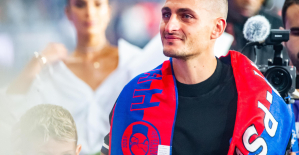 Mercato: Verratti at Barça? A track studied
Mercato: Verratti at Barça? A track studied Rugby: after the defeat during the Six Nations, the Blues will meet the English in September for a test match
Rugby: after the defeat during the Six Nations, the Blues will meet the English in September for a test match Premier League: Liverpool unveils its new jersey for next season
Premier League: Liverpool unveils its new jersey for next season Formula 1: Alpine holds its new executive technical director
Formula 1: Alpine holds its new executive technical director